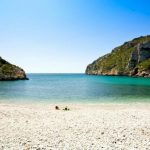Located in the heart of the Costa Blanca, Montgó Natural Park is a breathtaking gem that graces the landscape of Jávea, Spain. Known for its stunning biodiversity, dramatic geological formations, and panoramic views of the Mediterranean, this park is a must-visit destination for nature enthusiasts. The park spans over 2,117 hectares, with Montgó Mountain as its crown jewel, standing 753 meters tall and providing an unforgettable experience for all who visit.
The Geology of Montgó Mountain
Montgó Mountain is the centerpiece of the park, a limestone massif that has stood the test of time for over 70 million years. Its rugged cliffs, karst formations, and unique sedimentary layers narrate the geological evolution of the region. From a distance, the mountain's profile resembles a sleeping elephant, an endearing feature that adds to its charm.
The caves and crevices of Montgó, such as Cova del Camell and Cova de l’Aigua, are popular spots for explorers. These caves showcase intricate formations of stalactites and stalagmites while offering a peek into the area's historical significance with artifacts from prehistoric times.
Flora and Fauna: A Biodiversity Hotspot
Montgó Natural Park is home to an incredible variety of flora and fauna, making it a paradise for biologists and nature lovers. Over 650 plant species thrive here, including aromatic Mediterranean herbs like rosemary, thyme, and lavender. The park is also home to several endemic species, such as the Montgó milkvetch, which add to its ecological significance.
Birdwatchers will be delighted by the diversity of avian species, from majestic birds of prey like eagles and peregrine falcons to smaller migratory birds. The park is also inhabited by mammals such as foxes, wild boars, and rabbits, along with reptiles and insects that contribute to its thriving ecosystem.
Activities in Montgó Natural Park
Montgó Natural Park offers a wealth of activities for visitors, catering to all levels of fitness and adventure.
1. Hiking:
The park boasts a variety of hiking trails that range from easy to challenging.
- Summit Trail (Ruta del Montgó): This is the most popular trail, taking hikers to the peak of Montgó Mountain. The 8-kilometer round-trip journey offers spectacular views of Jávea, Dénia, and the Mediterranean Sea.
- Cova de l’Aigua Trail: A moderate hike that leads to the ancient Cova de l’Aigua, known for its Roman inscriptions.
- Les Planes Route: A family-friendly path that takes visitors through the flat terrain of the park, surrounded by wildflowers and Mediterranean scrubland.
2. Birdwatching and Wildlife Observation:
With its diverse range of habitats, Montgó Natural Park is an excellent place to spot birds and other wildlife. Bring binoculars and patience for the best experience.
3. Photography:
The park’s dramatic cliffs, vibrant flora, and scenic vistas make it a dream destination for photographers. Sunrise and sunset are particularly magical times for capturing its beauty.
Cultural and Historical Treasures
Montgó Natural Park is steeped in history, with archaeological sites that reflect the rich cultural heritage of the area.
- Cova de l’Aigua: This ancient cave contains inscriptions from the Roman era, offering a glimpse into the lives of those who once lived here.
- Alt de Benimaquia: This Iberian settlement is a fascinating site where winemaking tools from over 2,000 years ago have been discovered, shedding light on the region’s agricultural history.
The park’s proximity to the historic towns of Jávea and Dénia allows visitors to extend their exploration to charming old streets, local museums, and iconic landmarks.
Best Times to Visit
Each season offers something unique in Montgó Natural Park:
- Spring: Wildflowers bloom, filling the park with vibrant colors and fragrances.
- Summer: Early morning hikes are ideal, as the temperatures are cooler, and the Mediterranean breeze provides relief.
- Autumn: Migratory birds make their appearance, making it a perfect time for birdwatching.
- Winter: The crisp air and clear skies create excellent conditions for hiking and photography.
ctical Tips for Visitors
- Plan Your Visit: Check weather forecasts and trail conditions to ensure a safe and enjoyable experience.
- Wear Appropriate Gear: Comfortable hiking boots, sun hats, and lightweight clothing are essential.
- Stay Hydrated: Carry plenty of water, especially during longer hikes.
- Respect Nature: Stick to marked trails, avoid disturbing wildlife, and leave no trace behind.
- Local Guides: Hiring a guide can enrich your visit with insights into the park’s ecology and history.
Why Montgó Natural Park Should Be on Your Bucket List
Montgó Natural Park is more than just a natural reserve; it’s a sanctuary where geology, ecology, and history converge. Whether you’re scaling the heights of Montgó Mountain, exploring ancient caves, or simply soaking in the tranquility of the Mediterranean landscape, the park offers an experience that rejuvenates the body, mind, and spirit.
Frequently Asked Questions (FAQs)
What makes Montgó Natural Park unique?
Its combination of stunning biodiversity, rich geological history, and cultural significance sets it apart
Are there easy hiking trails in the park?
Yes, trails like Les Planes Route are suitable for families and beginners
Can I visit the park year-round?
Absolutely, though spring and autumn are particularly recommended for mild weather and vibrant wildlife
Are guided tours available?
Yes, local guides offer insightful tours that cover the park’s natural and historical highlights
Is there an entry fee for Montgó Natural Park?
No, the park is free to enter and explore, though guided tours may have a cost.




